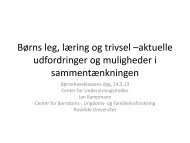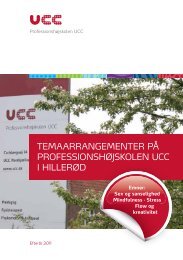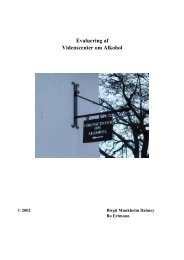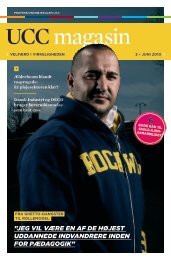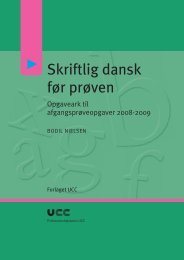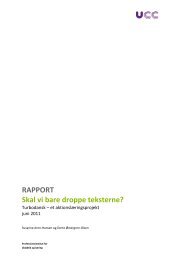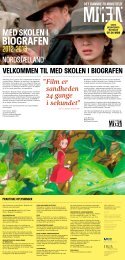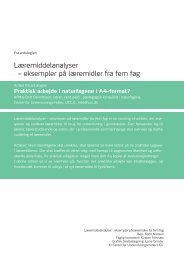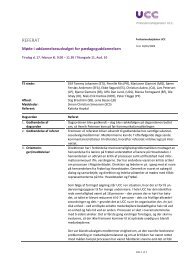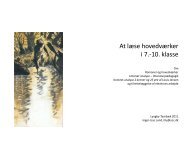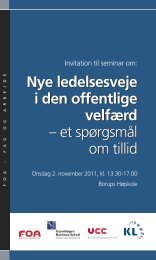AGORA - tidsskrift for forskning, udvikling og idéudveksling i ...
AGORA - tidsskrift for forskning, udvikling og idéudveksling i ...
AGORA - tidsskrift for forskning, udvikling og idéudveksling i ...
You also want an ePaper? Increase the reach of your titles
YUMPU automatically turns print PDFs into web optimized ePapers that Google loves.
<strong>AGORA</strong> - <strong>tidsskrift</strong> <strong>for</strong> <strong>for</strong>skning,<br />
<strong>udvikling</strong> <strong>og</strong> <strong>idéudveksling</strong> i professioner<br />
of the specific skill to be per<strong>for</strong>med, especially if the training is based on an instructional pedag<strong>og</strong>y. But<br />
also in many life situations, individuals are preoccupied with future situations, concerns, expectations or<br />
outcomes – instead of staying in and also appreciating the present moment. In our earlier years, though,<br />
we started out by being in the immediate moment: think about a small child: the child is not able to<br />
anticipate the future. Naturally the child stays in the present moment and is totally absorbed by being in<br />
the activity. Sports and meditation are two areas where attention training is developed. Actually, being<br />
attentive to the present moment is not different from what could be called meditation. In that sense, a<br />
meditative state is not by definition connected to religion or New Age movements. This meditative state<br />
of attentiveness and of being in the present moment includes epoché, an attitude which is characterized by<br />
the suspension of judgement. As described earlier, epoché is based on the redirection of our attention from<br />
“the exterior” to “the interior” which means we focus on things in ourselves or the environment through<br />
focusing on the immediate experience of the present moment.<br />
What can attention training or movement meditation look like in sports? By sensing, with immediate<br />
attention to and consciousness of situational factors, e.g., specific movement elements, sounds in the<br />
environment, one’s own breathing, the way the ball flies, etc., the athlete has a good possibility of<br />
restraining and suppressing disturbance which is normally caused by reflective thinking about the<br />
situation. The inner game approach developed by Gallwey and Kriegel (Gallwey, 1976; Gallwey, &<br />
Kriegel, 1977) works with a model that uses a similar idea of a perceptional focus on the immanent<br />
situational qualities as a fundamental basis <strong>for</strong> a light and undisturbed learning process where athletes<br />
are able to avoid distraction created through critical thinking about rules, technique or mistakes. A focus<br />
on selected elements while moving sharpens the intentional orientation towards the specific situational<br />
factors. In that sense, we stimulate our orientation towards the kairos, the propitious moment <strong>for</strong> decision<br />
and action. We know what to do at the right moment without any reflection. Our bodily attention which<br />
mirrors the intensive and immediate intentional orientation to the environment implies a readiness <strong>for</strong><br />
action that fits the situation.<br />
This attentive orientation can be supported by coaching interventions, which means supporting<br />
the person to be coached in his or her own ef<strong>for</strong>ts to intensify the dial<strong>og</strong>ue with the environment and<br />
the tasks at hand (Stelter, 2002; in press). By giving assignments or asking relevant questions, the coach<br />
can support the perceptual focus of the athlete(s). The coach can, <strong>for</strong> example, suggest a task-relevant<br />
orientation towards specific elements “inside” the athlete(s) or towards environmental factors (surface,<br />
wind, sounds, equipment, other players, etc.) – depending on the specific character of the sport or on<br />
particular individual challenges.<br />
Further ideas <strong>for</strong> exercise are:<br />
• Attention on the hara-centre or the centre of gravity: Many movements originate from this point, and<br />
focusing on it can help the athlete to be more centred in his/her per<strong>for</strong>mance. All Asian martial arts<br />
work very determinedly on focusing on the hara-centre.<br />
• Attention on breathing: In many activities and movements it is beneficial to coordinate the execution<br />
of a specific movement with the breathing rhythm. For example, if somebody is challenged by finding<br />
a good rhythm in crawl swimming, one of the central focus points could be the breathing rhythm and<br />
its coordination with the movement. A similar approach could be applied in skiing by combining the<br />
cut of the turn with breathing out.<br />
• Attention on specific parts of the body: The execution of movements can be supported by a focus<br />
that helps the athlete to avoid distractions and that helps to sharpen the awareness of an important<br />
www.cvustork.dk/agora/ 17





